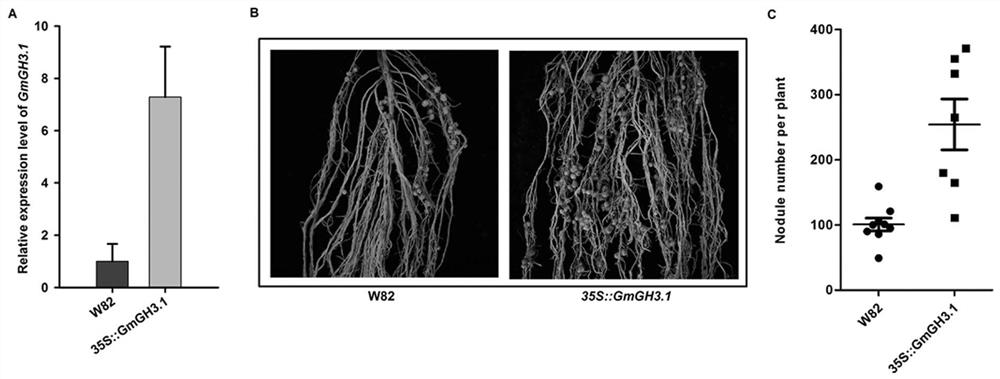A method for cultivating high-nodulation nitrogen-fixing transgenic plants
A transgenic plant, nitrogen fixation technology, applied in the field of genetic engineering
- Summary
- Abstract
- Description
- Claims
- Application Information
AI Technical Summary
Problems solved by technology
Method used
Image
Examples
Embodiment 1
[0031] Example 1, Extraction of total RNA in Wilimas82 soybean tissue.
[0032] The mortar has been treated at 180 ℃ for 8 hours or burned to eliminate RNase contamination; reagents such as chloroform, isopropanol, and ethanol should be freshly opened and uncontaminated; other equipment such as pipette tips, centrifuge tubes and reagents such as ultrapure water , NaAc, were treated with 1‰ DEPC water overnight, and then sterilized by high temperature and humidity at 121 ℃ for 30 minutes. The pipette tip and centrifuge tube were dried at 65 ℃ for later use; the total RNA of soybean was extracted by Trizol method.
[0033] (1) Take 50 mg of the material (leaf) and grind it with liquid nitrogen, add 1 mL of TRI pure reagent, after fully homogenizing, inhale the homogenate into a 1.5 mL centrifuge tube, and place it at room temperature for 5 min;
[0034] (2) Add 200 μL of chloroform, vortex to mix, let stand for 5 minutes, 4 ℃, 12000 r / min, centrifuge for 10 minutes;
[0035] (3...
Embodiment 2
[0037] Embodiment 2, reverse transcription PCR.
[0038] (1) Sequentially add 5 μL RNA and 3 μL oligo dt to a 200 μL PCR tube treated with DEPC; 4 μL dNTPs, incubate at 65 °C for 5 min and then quickly cool on ice;
[0039] (3) Add the following solutions in the following order: 5X M-MLV buffer (manufactured by Invitrogen) 4 μL, RNase inhibitor 1 μL, M-MLV 1 μL, 0.1M DTT 2 μL;
[0040] (4) Mix the above reaction solution and react at 37 °C for 30 min;
[0041] (5) After the reaction, treat at 70 °C for 10 min to inactivate the reverse transcriptase activity; the first strand of cDNA synthesized by the reaction can be used as a template for PCR reaction.
Embodiment 3
[0042] Example 3. Construction of recombinant expression vectors.
[0043] (1) GmGH3.1 Cloning of gene fragments.
[0044] according to GmGH3.1 A primer pair was designed for the coding sequence (SEQ ID NO; 1) for the construction of an overexpression vector. According to the multiple cloning site on the vector pTF101, the ends of the primers were respectively introduced into Xba I and Bam H I digestion recognition site; carry out PCR with the cDNA of soybean sequencing variety W82 as template, amplify GmGH3.1 A 1782 bp gene fragment (SEQ ID NO: 1); the primer sequence is:
[0045] Forward primer: CGCGGATCCATGGCCGTTGATTCTGAG (SEQ ID NO: 2);
[0046] Reverse primer: GCTCTAGATCAACGACGACGTTCTGG (SEQ ID NO: 3);
[0047]The amplification program is: 95°C for 5 minutes; 95°C for 30 seconds, 56°C for 30 seconds, 68°C for 2 minutes, 30 cycles; 72°C for 70 seconds;
[0048] The PCR amplification product was electrophoresed on 1% agarose gel, and the band of about 1782bp was...
PUM
 Login to View More
Login to View More Abstract
Description
Claims
Application Information
 Login to View More
Login to View More - R&D
- Intellectual Property
- Life Sciences
- Materials
- Tech Scout
- Unparalleled Data Quality
- Higher Quality Content
- 60% Fewer Hallucinations
Browse by: Latest US Patents, China's latest patents, Technical Efficacy Thesaurus, Application Domain, Technology Topic, Popular Technical Reports.
© 2025 PatSnap. All rights reserved.Legal|Privacy policy|Modern Slavery Act Transparency Statement|Sitemap|About US| Contact US: help@patsnap.com


